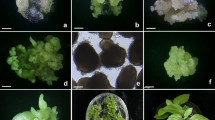Abstract
Embryogenic callus was induced from immature embryos of Angelica sinensis cultured on Murashige and Skoog (MS) basal medium. Embryogenic callus growth was more rapid on MS basal medium than on B5 or White medium. Embryogenic callus was used to establish a suspension culture and somatic embryos and germinating embryos developed during the culture. A shaking speed of 80 rpm was found to be optimal for establishing suspension cultures, while 100 rpm produced more somatic embryos and germinating embryos with an initiation cell density of 0.2 ml packed cell volume/25 ml medium. Adding 0.3% agar to the liquid medium also stimulated the formation of somatic and germinating embryos. While no plant growth regulators were needed for culture initiation and plant regeneration, the addition of 0.5–1 mg/l 2,4-dichlorophenoxyacetic acid was needed to maintain the embryogenic suspension culture by preventing embryo germination. Forty percent of the germinating embryos survived after culturing on filter paper moistened with liquid half-strength MS medium containing 3% sucrose. The plants were successfully transferred into soil.
Similar content being viewed by others
Author information
Authors and Affiliations
Additional information
Received: 19 March 1997 / Revision received: 21 November 1997 / Accepted: 19 January 1998
Rights and permissions
About this article
Cite this article
Tsay, H., Huang, H. Somatic embryo formation and germination from immature embryo-derived suspension-cultured cells of Angelica sinensis (Oliv.) Diels. Plant Cell Reports 17, 670–674 (1998). https://doi.org/10.1007/s002990050463
Issue Date:
DOI: https://doi.org/10.1007/s002990050463




